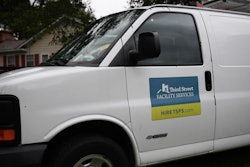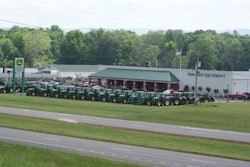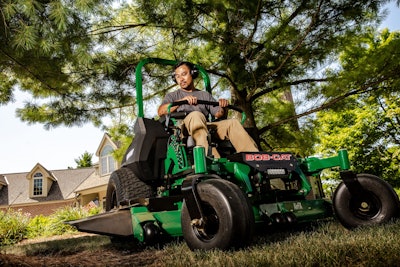 Photo: Bob-Cat Mowers
Photo: Bob-Cat MowersWith landscapers gearing up for the upcoming season, now’s an excellent time to take a look at mower fleets to make sure your machines are up to par for the tasks ahead.
Preventative maintenance
As the saying goes, the best defense is a good offense, and when it comes to mower preparation, preventative maintenance is a great way to avoid unnecessary downtime.
“Preventative maintenance is really the best way to keep heavily used mowers up and running and downtime at a minimum,” says Brad Unruh, director of new product development for Hustler Turf Equipment. “For landscape contractors who make a living with their mowers, they really can’t afford to have them breakdown. And once the grass starts growing, it doesn’t stop. Being able to count on your mower’s performance is a must.”
According to Ron Scheffler, senior product manager for Bob-Cat, one important preventative measure than can be taken to help mowers run longer is to make sure the entire mower is kept clean from top to bottom.
Scheffler recommends cleaning the mower after each use to keep debris and clippings away from the air intakes, rotating components and other areas where heat may build up and potentially hurt the components of the mower.
Unruh says to make sure the underside of the deck is also clean to prevent rust and keep air movement going, which will result in a cleaner cut and discharge. He also recommends taking your mower to the dealer once a year to get it serviced, and this can be done either at the start of the season or at the end.
“Cleaning your mower also helps you identify areas where there might be existing damage that needs addressing,” says Unruh.
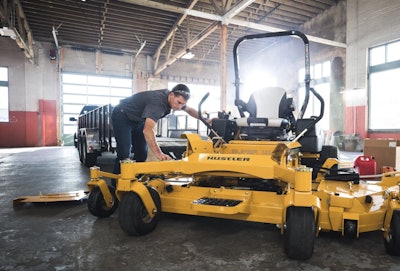 Photo: Hustler Turf Equipment
Photo: Hustler Turf EquipmentUnruh recommends blowing the machine off after use. Many users prefer to use water and Unruh says that’s fine, but it’s important to avoid using a pressure washer, as this could damage the seals.
Depending on the cutting conditions, Scheffler says it may be necessary to clean the mower after each cutting job instead of at the end of the day, as excessive build up can cause cut quality issues.
“A landscaper needs to be able to see under the mower deck and ensure the baffles are not damaged, to be able to access components for servicing or to check that something is not damaged to be able to evaluate the mower properly and ensure the safety of the crew and equipment,” says Scheffler.
Along with daily cleanings, landscapers should perform daily safety inspections on mowers before hitting the jobsite. Unruh recommends taking time to walk around your mower to make sure it’s in working order and operating at maximum efficiency.
Repairs and replacements
Regardless of how much you prepare, there will always come a time when your mower will experience an issue.
Repairs are inevitable with these pieces of equipment, and the price of repairs can range considerably depending on the severity of the situation.
“The average cost of a repair will vary dealer to dealer and is also dependent on the kind of repair itself,” says Scheffler. “A simpler premaintenance service item will typically be a lower cost than a different kind of repair.”
Unruh says when the season hits, many service centers could be about a week out on repairs, which is why he stresses the importance of routine preventative maintenance.
While there’s no guarantee that your dealer will be able to get repairs done as quickly as you would like, Scheffler says establishing strong relationships with your local dealer is always a good idea.
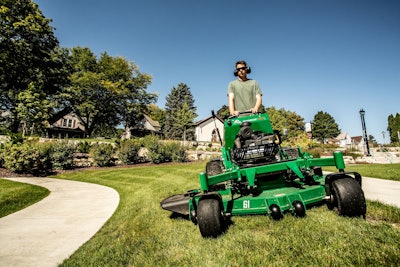 Photo: Bob-Cat Mowers
Photo: Bob-Cat Mowers“Commercial landscapers that buy their mowers from the dealer that they take their mower to for service will typically get preferential treatment for a quick turn-around to get them back up and running,” says Scheffler. “Dealers know that a mower that isn’t cutting grass isn’t making money.”
Scheffler adds that dealers aren’t always able to pull those kinds of strings, however, so you should always have a backup plan in place to avoid costly downtime in the field.
Unruh says Hustler Turf does offer a loaner program through their network of dealers if you should need that type of service.
Scheffler adds that Bob-Cat dealers are independent and might have their own individual programs regarding loaner mowers, so he encourages customers to inquire with their local dealer upon bringing the mower in for repairs.
Both experts agree that many of their dealers also offer trade-in programs when it comes time to upgrade your equipment.
Many landscapers wonder just when the right time is to replace a mower instead of opting for a repair, and experts agree that it can vary depending on the frequency of use, the terrain the mowers are used on and how well the user maintains the machine.
“Some contractors like to replace their mowers once they reach a certain number of hours or years used,” says Unruh. “Others prefer to get a new mower once theirs is out of warranty. We also see landscape contractors in areas like Florida replacing their mowers much sooner than those in areas like the Northeast.”
Scheffler reiterates that mowers that are well cared for have a better chance of lasting longer, but he does say it comes down to the landscaper’s personal preference as to whether it’s time to take the leap and replace or hold out a little longer with a repair.




